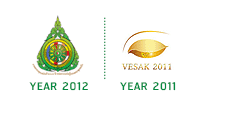05/24/13
Filed under:
General
Posted by:
site admin @ 7:16 am
930 LESSON 25-05-2013 SATURDAY-FREE ONLINE eNālāndā Research and Practice UNIVERSITY-
Happy Vesak - People all over the world hope our Raj Bhavan, Parliament, Rajya Sabha, The White House, and all our Media celebrate Buddha Jayanthi in a grand manner for the Welfare, Happiness and Peace of the entire people.
Please watch
http://archive.org/details/BuddhasLifeAnimation2007Thai_201303
for
Buddha’s Life Animation ( 2007) Thai (March 25, 2013)
Buddha life Cartoon Animation
1Hr. 38 Mins
http://archive.org/details/KimClarkBuddha_sTeachingonLoving-KindnessforA synopsis of the Buddha’s world view is followed by a hauntingly
beautiful rendition of his teaching on Loving-Kindness, the Metta Sutta.
6.21 mins
http://in-mg61.mail.yahoo.com/neo/launch#mail
[Attachment(s) from vinaya rakkhita included below]
|
Dear All,
Wish You All Happy Budddha Jayanthi /UN Vesak - 2013 CE/2556 BE
February 2nd, 2013 by david
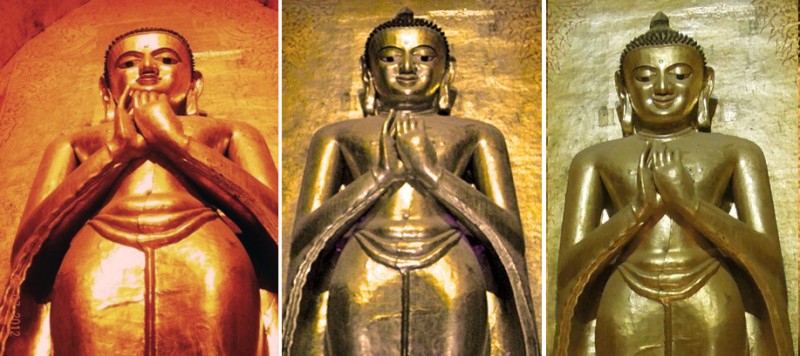
In this wonderful image of the Buddha from
Bagan, Myanmar, facial expression changes from stern through smiling to
radiant as the figure is viewed from increasing distance. According to
my friend Eddy Keon, the highest status members of the temple audience,
along with temple officials, would have stood closest to the Buddha and
therefore have experienced him at his sternest, whilst his radiance
increased with the poverty of the viewer, banished to the back of the
crowd.
The figure is the Kassapa Buddha, one of four Buddhas in the Ananda Temple, Bagan, Myanmar.
The city was the capital of the ancient Pagan kingdom, built, along
with the temple and this figure of the Buddha, eight hundred years ago.
The left hand and centre photos are from the brilliant travel blog of Forrestwalker.
The right hand image was taken by Eddy Keon. His photo is so
beautiful, here’s the whole thing. Eddy hopes to use his pictures to support a hill village school in Myanmar.
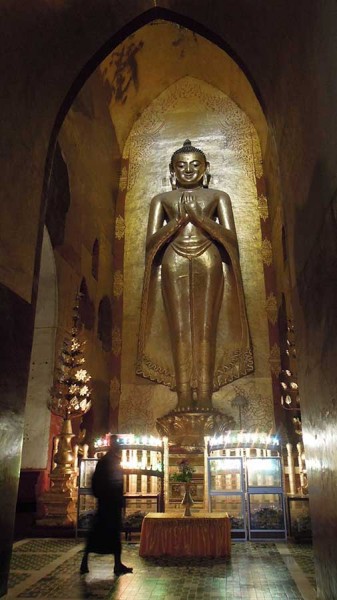
http://www.desktopnexus.com/tag/buddha/
http://abstract.desktopnexus.com/wallpaper/1459670/
Zen meditation

http://architecture.desktopnexus.com/wallpaper/1432375/
http://nature.desktopnexus.com/wallpaper/1414891/
http://www.undv.org/vesak2013/en/aboutundv.phpwith metta,
Bhanteji
|
__._,_.___
Attachment(s) from vinaya rakkhita
1 of 1 Photo(s)
 |
 |


| |
Story of each Vesak Celebrations
History of UN Day of Vesak Celebrations
International Council of the United Nations Day of Vesak
International Association of Buddhist Universities
Officers and Location
Background & Objectives
on The International Celebration on the Occasion of United Nations Day of Vesak
|
|
|
|
|
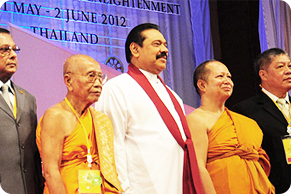 |
International Buddhist Conference on the United Nations Day of
Vesak At Conference Hall Mahachulalongkornrajavidyalaya University,
Main Campus, Wang Noi, Ayutthaya and United Nations Conference Centre,
Bangkok, The Kingdom of Thailand 31 May – 02 June 2012 /2555
Participants : 5,000 Buddhist leaders, scholars, delegates and observers from all over the world are expected to attend the conference.
|
|
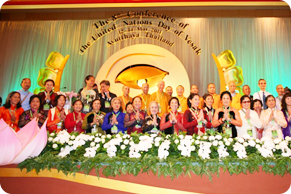 |
International Buddhist Conference on the United Nations Day of
Vesak At Conference Hall Mahachulalongkornrajavidyalaya University,
Main Campus, Wang Noi, Ayutthaya and United Nations Conference Centre,
Bangkok, The Kingdom of Thailand 12-14 May 2011/2554
Participants : 5,000 Buddhist leaders, scholars, delegates and observers from all over the world are expected to attend the conference.
|
|
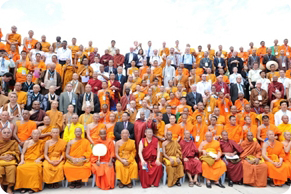 |
International Buddhist Conference on the United Nations Day of
Vesak At Conference Hall Mahachulalongkornrajavidyalaya University,
Main Campus, Wang Noi, Ayutthaya and United Nations Conference Centre,
Bangkok, The Kingdom of Thailand 23-25 May 2553/2010
Participants : 5,000 Buddhist leaders, scholars, delegates and observers from all over the world are expected to attend the conference.
|
|
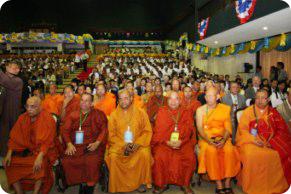 |
International Buddhist Conference on the United Nations Day of
Vesak At Conference Hall Mahachulalongkornrajavidyalaya University,
Main Campus, Wang Noi, Ayutthaya and United Nations Conference Centre,
Bangkok, The Kingdom of Thailand 4-6 May 2552/2009
Participants : Over 2,000 Buddhist leaders, scholars and delegates from all over the world are expected to attend the conference.
|
|
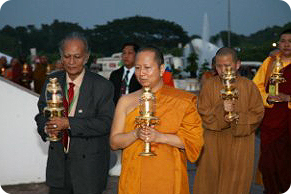 |
Between 18-19 May 2008, Mahachulalongkornrajavidyalaya
University and ICDV,hosted the 2nd International Buddhist Conference on
the United Nations Day of Vesak at Buddhamonthon Conference Hall ,
Nakhon Pathom Province, The Kingdom of Thailand.
Emphasis : The emphasis of the conference was to
promote and support sustainable development; resolve that Buddhamonthon,
The Kingdom of Thailand should be recognized as the Center of world
Buddhism; play a leading role in coordinating between Buddhist
institutions and in promoting and sharing Dhamma resources.
|
|
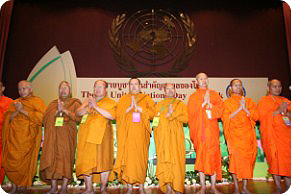 |
Between 26 – 29 May 2007, Mahachulalongkornrajavidyalaya University, in
conjunction with ICDV and the Sangha Supreme Council hosted the 4th
International Buddhist Conference on the United Nations Day of Vesak at
Buddhamonthon, Nakhon Pathom Province, and at the United Nations
Conference Centre in Bangkok, The Kingdom of Thailand.
Participants : Over 2000 Buddhist leaders, scholars and delegates from all over the world are expected to attend the conference.
Emphasis : This year’s conference emphasizes Buddhism
and good governance, and marks the Auspicious Occasion of His Majesty
King Bhumibol Adulyadej’s 80th Birthday Anniversary.
|
|
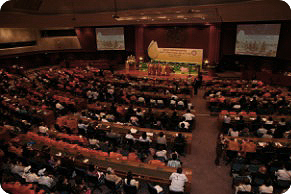 |
Between 7 – 10 May 2006, Mahachulalongkornrajavidyalaya
University and ICDV, in conjunction with the Sangha Supreme Council and
the Thai Government hosted the 3rd International Buddhist Conference on
the United Nations Day of Vesak at Buddhamonthon, Nakhon Pathom
Province, and at the United Nations Conference Centre in Bangkok, The
Kingdom of Thailand.
Emphasis : The conference emphasized world peace,
cooperation between all schools of Buddhism, sustainable development,
and the sufficiency-economy theories of H.M.King Bhumibol.
|
|
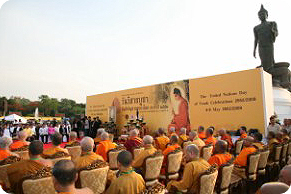 |
Between 18-21 May 2005, Mahachulalongkornrajavidyalaya
University and ICDV,hosted the 2nd International Buddhist Conference on
the United Nations Day of Vesak at Buddhamonthon Conference Hall ,
Nakhon Pathom Province, The Kingdom of Thailand.
Emphasis : The emphasis of the conference was to
promote and support sustainable development; resolve that Buddhamonthon,
The Kingdom of Thailand should be recognized as the Center of world
Buddhism; play a leading role in coordinating between Buddhist
institutions and in promoting and sharing Dhamma resources.
|
|
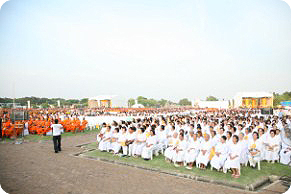 |
On 25 May 2004, Mahachulalongkornrajavidyalaya University and ICDV
held the World Buddhist Leaders Conference on International Recognition
of the Day of Vesak at Buddhamonthon Conference Hall , Nakhon Pathom
Province, The Kingdom of Thailand.
Emphasis : The emphasis of the conference was to study,
practice, propagate and protect Buddhism and to jointly organize the
Vesak Day celebration at the United Nations Headquaters and at the UN
regional offices.
|
|
|
 |
 |
Friends:
At this Fullmoon Day do all Buddhas Awaken:
24th May 2013 Vesak Day celebrates birth, Enlightenment, and passing away
of the Buddha Gotama. Rejoice! Keep clean, calm, cool, clever, and caring…
About this Buddhist Vesak Festival: http://en.wikipedia.org/wiki/Vesak
This May full moon also celebrates the Buddha’s third visit to Sri Lanka in
the eighth year after his Enlightenment, where he journeyed to Kelaniya on
the invitation of the Nāga King Maniakkhika (Mahavamsa i,72ff.).
The day also celebrates the crowning of king Devānampiyatissa (Mhv.Xi.42),
and the laying of the foundation stone of the Mahā Stūpa (Mhv.Xxix.1)
Please Remember:
At this very May full moon in year 528 BC the Blessed Buddha awakened
by completely perfect and utterly unsurpassable self-Enlightenment!
At that time a girl named Sujata Senani lived in Uruvela. When adult she
prayed before a certain Banyan tree, that she might get a good husband
equal to herself in caste & that her firstborn may be a son. Her prayer was
successful. Since indeed it did happen. At the full moon day of the Wesak
month, she rose at early dawn and milked the cows. As soon as new buckets
were placed under the cows, the milk poured spontaneously in streams all by
itself! Seeing this miracle, she knew something special was happening!
That same night the Future Buddha dreamt 5 dreams making him conclude:
“Surely, truly, without any doubt, today I will reach perfect Enlightenment!”
His 5 colored radiance illuminated the whole tree. Then Sujata came and
offered the cooked milk rice into the hands of this Great Being.
Later a local grass-cutter came going with a bundle of grass just harvested
from nearby. He offered the Great Being 8 handfuls of Kusa grass, when he
saw that this Sage was a Holy Man. The Future Buddha accepted the grass
and proceeded to the foot of the Bodhi-tree. Reaching the imperturbable
Eastern side, where all the Buddhas take their seat, he sat down saying to
himself: This is the immovable spot, where all the prior supreme Buddhas
have planted themselves! This is the place for destroying this net of desire!
Then the Future Buddha turned his back to the trunk and thus faced east.
Right there, he then resolutely settled on this mighty decision:
Let just blood and flesh of this body dry up & let skin and sinews fall from
the bones. I will not leave this seat before having attained the absolute and
Supreme Self-Enlightenment!
So determined did he seat himself in this unconquerable seat, from which
not a 100 lightning strikes could make him waver. At this very moment
the rebel deity Mara -The Evil One- raised exclaiming: Prince Siddhattha will
pass beyond my power, but I will never allow it! And sounding the Mara’s war
shout, he summoned his mighty army for battle. Then Mara warned his evil
militia: This Sakyamuni, son of Suddhodana, is far greater than any other
man, so we will never succeed to fight him up front. We must thus attack
him from the rear. Frustrated, being unable even to touch this big wielder
of power also with 9 mighty hurricanes of wind, rain, rocks, weapons, red
coals, hot ashes, sand, mud, and darkness Mara somewhat in panic shouted
at his army: “Why do you all stand still? Seize, kill & drive away this prince!”
Mara then yelled: “Siddhattha, leave this seat. It is not yours, but mine!”
Hearing this, the Well-gone One replied: Mara, neither have you fulfilled the
10 perfections to the third degree, nor have you given the 5 great donations.
Neither have you striven for insight, nor for the welfare of all the world,
nor for supreme self-enlightenment! Therefore does this very seat surely
not belong to you, but truly indeed only to me. Suddenly overpowered by fear
Mara’s followers fled helter-skelter in all directions. No two went in the
same direction, but leaving their weapons in a chaos, they all fled terrified
by metaphysical panic. Seeing them flee thus, the great assembly of deities
triumphantly shouted: Mara is defeated. Prince Siddhattha has won! Let us
celebrate this truly sublime, wonderful and unique victory! It was before
the sun had set that the Tathagata conquered Mara and defeated his army.
That same night, after having bathed, while the Bo tree rained red sprigs onto
his robe, The Consummate One gained knowledge of his prior lives during the
1st watch of the night: “With the mind thus concentrated, purified, bright,
unified, focused, tractable, compliant, steady & imperturbable, I directed
mind to remembrance of my past lives. I recollected many past lives, i.e., one
re-birth, two…five, ten… 50, a hundred, a thousand, 100 thousand, many eons
of cosmic contraction, & many eons of cosmic expansion: There I had such
a name, belonged to such a clan & species, had such a body. Such was my food,
such my life of pleasures and pains. Such was the end of my life. Passing away
from that state, I re-arose there. There I had such name, belonged to such
a sort & family, had such a form. Such was my food, such my experience of
pleasures & pains. Such was the end of my life. Passing away from that state,
I re-arose here. Thus I remembered my various past lives in all their various
modes and manifold details. This was the first knowledge I attained in the
first watch of the night. Ignorance was destroyed; the knowledge arose;
darkness was destroyed; light arose as happens in one who is alert, aware,
and determined. But the very pleasant feeling that arose by this did neither
invade my mind, nor remain. With the mind thus concentrated, purified, bright,
intact, pliant, malleable, steady, and totally imperturbable, I directed it to
the knowledge of the passing away and reappearance of beings. I saw by
means of the divine eye, purified & surpassing the human eye! I saw beings
passing away & re-appearing, and I realized how & why they are high or low,
beautiful or ugly, fortunate and unfortunate all in exact accordance with
the intentions of their prior actions: These beings who were endowed with
bad behaviour of body, speech, and mind, who reviled the Noble Ones, held
wrong views & acted under the influence of wrong views, with the break-up
of the body, after death, have re-appeared in the plane of misery, the bad
painful destination, the lower realms, even in hell. But the beings who were
gifted with good behaviour of body, speech and mind, who did not revile the
Noble Ones, who held right views and acted under the influence of right
views after the break-up of the body, after the death, have re-appeared in
happy destinations, even in a divine world! Thus by means of the divine eye,
purified and surpassing the human I saw beings passing away & re-appearing,
all in accordance with their particular mixture of good and bad kamma…
But the satisfaction that arose here did neither invade my mind, nor remain.
With the mind thus concentrated and completely absorbed, I then directed
it towards understanding the ending of mental fermentation. I realized how
it actually comes to be, that:
This is Suffering…
Such is the Cause of Suffering…
Such is the End of Suffering…
Such is the Way to End Suffering…
Such was the mental fermentations…
Such is the Cause of mental fermentation…
Such is the End of mental fermentation…
Such is the Way leading to the end of mental fermentation.
When my mind saw that, it was instantly freed of the fermentation of all
sense-desire, it was released from the fermentation of becoming, and it
became fully uncovered from the fermentation of ignorance. Thus fully and
perfectly Enlightened - The Buddha - perceiving this immense glory, spoke
these 2 solemn verses, which never has been omitted by any of countless
billions of prior Buddhas:
Through this round of countless existences have I searched, but yet failed
to find “the Creator”, who framed this construction: What Suffering indeed
is such endless birth, ageing, decay, sickness and ever repeated death!
Now I see that “the Constructor” of this structure is Craving…!!! Never shall
this construction be built again, since all the rafters are shattered and the
main beam is busted and completely broken… At this calming of all Craving,
the mind was finally, irreversibly and ultimately stilled…
Then, friends, this revelation of certainty arose in me: This release is indeed
immutable, this is the very last rebirth, this endless reappearance has finally
come to a happy end… Nibbāna is verily the Highest Bliss!
About Absolute Awakening!
http://What-Buddha-Said.net/library/DPPN/b/buddha.htm
http://What-Buddha-Said.net/library/DPPN/g/gotama.htm
http://What-Buddha-Said.net/library/DPPN/s/sujaataa.htm
http://What-Buddha-Said.net/library/DPPN/b/bodhisatta.htm
http://What-Buddha-Said.net/library/DPPN/wtb/b_f/bodhi.htm
http://What-Buddha-Said.net/library/DPPN/b/bodhirukka.htm
http://What-Buddha-Said.net/library/DPPN/b/bodhimanda.htm
http://What-Buddha-Said.net/library/DPPN/wtb/s_t/sammaa_sambodhi.htm
Good Picture video of the Gotama Buddha’s life:
http://www.youtube.com/watch?v=UrrmOR9suvc
Source:
The Jātaka Nidāna. The story of Gotama Buddha.
Tr. by N.A. Jayawickrama, Pali Text Society 1990.
http://www.pariyatti.com/book.cgi?prod_id=132935
VESAK FESTIVAL VIDEO, COLOMBO 2011:
http://www.youtube.com/watch?v=RLScBZ1tW0A
http://www.youtube.com/watch?v=7eunH6Dh2mM
Happy Vesak to All Beings!
Friendship is the Greatest!
http://in-mg61.mail.yahoo.com/neo/launch#mail
Dear JC,
Good morning.
Hope things are fine at religious, political and home fronts.
I appreciate and acknowledge receipt of your recent valuable Mails.
out of so you had been sending meticulously.
- 3d street pictures- Hats off to the artist for his brilliance.
- Banta and Beer
The latest covering the wonderful and World Famous Budha statues
and most importantly the concise brief life history of lord Budha
on the eve of Budha Poornima.
Thanks once again.
with warm regards.
Dr Bala
MISUSE OF EVM _ PART -12
•
• New voter verifiable paper trail (VVPT) machines to replace the EVMs, following doubts that it could be tampered.Voting Machines are “Calculators which can be manipulated by computer softwares”. New Machines are ordered by EC, where a paper slip will come out with EVM voting which will be then deposited in a box. What is the use? Paper Slip will show that voter has casted vote for “Party A”, but calculator software will add vote to “Party B”! The Computers are programmable. No use for such fake paper slips. In Superior Courts it has been demonstrated how these computers can be manipulated and how it can be pre-programmed to make sure victory to one candidate during election. The EVM machines have killed Democracy and have all the potentials to do so. The ruling castes are manipulating EVMs to make sure victory to them depriving the dipressed classes to enable them to acquire the MASTER KEY that can unlock all doors of progress to the entire people.
•
• Under such circumstances the following exposure by media had no relevance during the last Karnataka Assembly Elections 2013 where the Congress won and the trend will continue in the forth coming General Elections until the Superior Court and the upholders of Democracy including the free and fair media.
7.2 Open Source Business Models and the Voting Systems Market
The larger information technology and services sector has seen a substantial growth in business activity directly or indirectly tied to open source software. Is disclosed and open source software something that would naturally arise in the voting systems market? The voting technology market and regulatory environment are sufficiently distinct that a direct translation of current open source business models is questionable. Here, we cover what business models from other open source business endeavors might be applicable in the voting systems market. In Section , we highlight some barriers to entry and ongoing business that such an enterprise might face.
A few ways to make money off of open source software used in the IT sector might apply to the business environment surrounding voting systems. Firms such as 10X Software make money off of integrating IT systems into operating environments. A similar idea could be extended to voting, where a system integrator would incorporate open source voting system software and voting hardware to produce a voting solution for a state or local jurisdiction. Some firms, such as Wild Open Source, structure their business around targeted development of open source software. A software firm could be hired by a jurisdiction to add, fix or modify certain features of an open source voting system to their own specifications. This could ensure that specific functionality, such as supporting Instant Runoff Voting, was available in the technology that the customer was going to purchase. This also has the benefit that a feature could be added to the software before the open source voting system as a whole was certified and minimize the costs of having to re-certify a base system with the contracted modifications. Dual licensing is where a company offers the same software under two different software licenses, usually one being free software or open source and the other being a commercial license.76This can allow their product to benefit from some aspects of open source development while also allowing their customers, commercial and non-commercial, flexibility in their licensing options. For example, MySQL AB offers its MySQL database software freely under the terms of the GNU GPL, but also allows companies to purchase commercial licenses that permit them to deviate from the terms of the GPL. In the voting systems context, a vendor could offer its software for free under a disclosed or open source license, but then charge commercial users to build variants. Companies could use the open source software simply to sell their hardware. That is, with open source software running their voting hardware, they can devote more resources to ensuring that their voting hardware is innovative and as cutting-edge and economical as their customers demand. For example, to concentrate their efforts at selling their high-quality hardware, Apple computer has embraced open source software as the core of their Mac OS X operating system.77
Some ways that companies use to make money off of open source do not translate well to the voting systems market. For example, Google’s business strategy involves running optimized web search services on server clusters running the Linux operating system. Given the concerns and problems with networking in election systems, it would be difficult for a company to make money off of running open source voting software remotely. IBM sells proprietary software that works on top of or in concert with open source software. A company that tried to do this in the voting market would have to marshal each version of its software package through certification, and then it would only be partially open as a whole.
(Sekhiyà)
Ime kho panàyasmanto sekhiyà dhammà uddesaü àgacchanti.
[BJT Vol II (I), Page 488] [\x 488/]
Sekh 1: (Parimaõóalasikkhàpadaü) : 31
Parimaõóalaü nivàsessàmã-ti, sikkhà karaõãyà.
[BJT Vol II (I), Page 490] [\x 490/]
Sekh 2:
Parimaõóalaü pàrupissàmã-ti, sikkhà karaõãyà.
Sekh 3: (Suppañichannasikkhàpadaü):
Supañicchanno antaraghare gamissàmã-ti, sikkhà karaõãyà.
Sekh 4:
Supañicchanno antaraghare nisãdissàmã-ti, sikkhà karaõãyà.
[BJT Vol II (I), Page 492] [\x 492/]
Sekh 5: (Susaüvutasikkhàpadaü):
Susaüvuto antaraghare gamissàmã-ti, sikkhà karaõãyà.
Sekh 6:
Susaüvuto antaraghare nisãdissàmã-ti, sikkhà karaõãyà.
Sekh 7: (Okkhittacakkhusikkhàpadaü):
Okkhittacakkhu antaraghare gamissàmã-ti, sikkhà karaõãyà.
[BJT Vol II (I), Page 494] [\x 494/]
Sekh 8:
Okkhittacakkhu antaraghare nisãdissàmã-ti, sikkhà karaõãyà.
Sekh 9: (Ukkhittakasikkhàpadaü):
Na ukkhittakàya antaraghare gamissàmã-ti, sikkhà karaõãyà.
Sekh 10:
Na ukkhittakàya antaraghare nisãdissàmã-ti, sikkhà karaõãyà.
Parimaõóalavaggo pañhamo
[BJT Vol II (I), Page 496] [\x 496/]
Sekh 11: (Ujjhagghikasikkhàpadaü):
Na ujjagghikàya antaraghare gamissàmã-ti, sikkhà karaõãyà.
Sekh 12:
Na ujjagghikàya antaraghare nisãdissàmã-ti, sikkhà karaõãyà.
Sekh 13: (Uccasaddàsikkhàpadaü):
Appasaddo antaraghare gamissàmã-ti, sikkhà karaõãyà.
[BJT Vol II (I), Page 498] [\x 498/]
Sekh 14:
Appasaddo antaraghare nisãdissàmã-ti, sikkhà karaõãyà.
Sekh 15: (Kàyappacàlakàdisikkhàpadaü):
Na kàyappacàlakaü antaraghare gamissàmã-ti, sikkhà karaõãyà.
Sekh 16:
Na kàyappacàlakaü antaraghare nisãdissàmã-ti, sikkhà karaõãyà.
[BJT Vol II (I), Page 500] [\x 500/]
Sekh 17: (Bàhuppacàlakasikkhàpadaü):
Na bàhuppacàlakaü antaraghare gamissàmã-ti, sikkhà karaõãyà.
Sekh 18:
Na bàhuppacàlakaü antaraghare nisãdissàmã-ti, sikkhà karaõãyà.
Sekh 19: (Sãsappacàlakasikkhàpadaü):
Na sãsappacàlakaü antaraghare gamissàmã-ti, sikkhà karaõãyà.
[BJT Vol II (I), Page 502] [\x 502/]
Sekh 20:
Na sãsappacàlakaü antaraghare nisãdissàmã-ti, sikkhà karaõãyà.
Ujjagghiakavaggo dutiyo
[BJT Vol II (I), Page 504] [\x 504/]
Sekh 21: (Khambhakatasikkhàpadaü):
Na khambhakato antaraghare gamissàmã-ti, sikkhà karaõãyà.
Sekh 22:
Na khambhakato antaraghare nisãdissàmã-ti, sikkhà karaõãyà.
Sekh 23: (Oguõñhitasikkhàpadaü):
Na oguõñhito antaraghare gamissàmã-ti, sikkhà karaõãyà.
[BJT Vol II (I), Page 506] [\x 506/]
Sekh 24:
Na oguõñhito antaraghare nisãdissàmã-ti, sikkhà karaõãyà.
Sekh 25: (Ukkuñikasikkhàpadaü):
Na ukkuñikàya antaraghare gamissàmã-ti, sikkhà karaõãyà.
Sekh 26: (Pallatthikasikkhàpadaü):
Na pallatthikàya antaraghare nisãdissàmã-ti, sikkhà karaõãyà.
[BJT Vol II (I), Page 508] [\x 508/]
Sekh 27: (Sakkaccapañiggahaõasikkhàpadaü):
Sakkaccaü piõóapàtaü pañiggahessàmã-ti, sikkhà karaõãyà.
Sekh 28: (Pattasa¤¤ãpañiggahaõasikkhàpadaü):
Pattasa¤¤ã piõóapàtaü pañiggahessàmã-ti, sikkhà karaõãyà.
Sekh 29: (Samasåpakapañiggahaõasikkhàpadaü):
Samasåpakaü piõóapàtaü pañiggahessàmã-ti, sikkhà karaõãyà.
[BJT Vol II (I), Page 510] [\x 510/]
Sekh 30: (Samatittikasikkhàpadaü):
Samatittikaü piõóapàtaü pañiggahessàmã-ti, sikkhà karaõãyà.
Khambhakavaggo tatiyo
[BJT Vol II (I), Page 512] [\x 512/]
Sekh 31: (Sakkaccabu¤janasikkhàpadaü):
Sakkaccaü piõóapàtaü bhu¤jissàmã-ti, sikkhà karaõãyà.
Sekh 32: (Pattasa¤¤ãbhu¤janasikkhàpadaü):
Pattasa¤¤ã piõóapàtaü bhu¤jissàmã-ti, sikkhà karaõãyà.
Sekh 33: (Sapadànasikkhàpadaü):
Sapadànaü piõóapàtaü bhu¤jissàmã-ti, sikkhà karaõãyà.
[BJT Vol II (I), Page 514] [\x 514/]
Sekh 34: (Samasåpakasikkhàpadaü):
Samasåpakaü piõóapàtaü bhu¤jissàmã-ti, sikkhà karaõãyà.
Sekh 35: (Nathåpakatasikkhàpadaü):
Na thåpato 32 omadditvà piõóapàtaü bhu¤jissàmã-ti, sikkhà karaõãyà.
Sekh 36: (Odanappañicchàdanasikkhàpadaü):
Na såpaü và bya¤janaü và odanena pañicchàdessàmi bhãyokamyataü 33 upàdàyàti, sikkhà karaõãyà.
[BJT Vol II (I), Page 516] [\x 516/]
Sekh 37: (Såpodanavi¤¤attisikkhàpadaü):
Na såpaü và odanaü và agilàno attano atthàya vi¤¤àpetvà bhu¤jissàmã-ti, sikkhà karaõãyà.
Sekh 38: (Ujjhànasa¤¤ãsikkhàpadaü):
Na ujjhànasa¤¤ã paresaü pattaü olokessàmã-ti, sikkhà karaõãyà.
Sekh 39: (Kabaëasikkhàpadaü):
Nàtimahantaü kabaëaü karissàmã-ti, sikkhà karaõãyà.
[BJT Vol II (I), Page 520] [\x 520/]
Sekh 40: (âlopasikkhàpadaü):
Parimaõóalaü àlopaü karissàmã-ti, sikkhà karaõãyà.
Sakkaccavaggo catuttho
[BJT Vol II (I), Page 522] [\x 522/]
Sekh 41: (Anàhañasikkhàpadaü):
Na anàhañe kabaëe mukhadvàraü vivarissàmã-ti, sikkhà karaõãyà.
Sekh 42: (Bhu¤jamànasikkhàpadaü):
Na bhu¤jamàno sabbaü hatthaü mukhe pakkhipissàmã-ti, sikkhà karaõãyà.
Sekh 43: (Sakabaëasikkhàpadaü):
Na sakabaëena mukhena byàharissàmã-ti, sikkhà karaõãyà.
[BJT Vol II (I), Page 524] [\x 524/]
Sekh 44: (Piõóukkhepakasikkhàpadaü):
Na piõóukkhepakaü bhu¤jissàmã-ti, sikkhà karaõãyà.
Sekh 45: (Kabaëavacchedakasikkhàpadaü):
Na kabaëàvacchedakaü bhu¤jissàmã-ti, sikkhà karaõãyà.
Sekh 46: (Avagaõóakàrakasikkhàpadaü):
Na avagaõóakàrakaü bhu¤jissàmã-ti, sikkhà karaõãyà.
[BJT Vol II (I), Page 526] [\x 526/]
Sekh 47: (Hatthaniddhunakasikkhàpadaü):
Na hatthaniddhunakaü bhu¤jissàmã-ti, 34 sikkhà karaõãyà.
Sekh 48: (Sitthàvakàrakasikkhàpadaü):
Na sitthàvakàrakaü bhu¤jissàmã-ti, sikkhà karaõãyà.
Sekh 49: (Jivhànicchàrakasikkhàpadaü):
Na jivhànicchàrakaü bhu¤jissàmã-ti, sikkhà karaõãyà.
[BJT Vol II (I), Page 528] [\x 528/]
Sekh 50: (Capucapukàrakasikkhàpadaü):
Na capucapukàrakaü bhu¤jissàmã-ti, sikkhà karaõãyà.
Kabaëavaggo pa¤camo
[BJT Vol II (I), Page 530] [\x 530/]
Sekh 51: (Surusurukàrakasikkhàpadaü):
Na surusurukàrakaü bhu¤jissàmã-ti, sikkhà karaõãyà.
Sekh 52: (Hatthanillehakàdisikkhàpadaü):
Na hatthanillehakaü bhu¤jissàmã-ti, sikkhà karaõãyà.
[BJT Vol II (I), Page 532] [\x 532/]
Sekh 53: (Pattanillehakasikkhàpadaü):
Na pattanillehakaü bhu¤jissàmã-ti, 35 sikkhà karaõãyà.
Sekh 54: (Oññhanillehakasikkhàpadaü):
Na oññhanillehakaü bhu¤jissàmã-ti, sikkhà karaõãyà.
[BJT Vol II (I), Page 534] [\x 534/]
Sekh 55: (Sàmisasikkhàpadaü):
Na sàmisena hatthena pànãyathàlakaü pañiggahessàmã-ti, sikkhà karaõãyà.
[BJT Vol II (I), Page 536] [\x 536/]
Sekh 56: (Sasitthakasikkhàpadaü):
Na sasitthakaü pattadhovanaü antaraghare chaóóessàmã-ti, sikkhà karaõãyà.
[BJT Vol II (I), Page 538] [\x 538/]
Sekh 57: (Chattapàõisikkhàpadaü):
Na chattapàõissa agilànassa dhammaü desissàmã-ti, 36 sikkhà karaõãyà.
Sekh 58: (Daõóapàõisikkhàpadaü):
Na daõóapàõissa agilànassa dhammaü desissàmã-ti, sikkhà karaõãyà.
[BJT Vol II (I), Page 540] [\x 540/]
Sekh 59: (Satthapàõisikkhàpadaü):
Na satthapàõissa agilànassa dhammaü desissàmã-ti, sikkhà karaõãyà.
Sekh 60: (âyudhapàõisikkhàpadaü):
Na àyudhapàõissa agilànassa dhammaü desissàmã-ti, sikkhà karaõãyà.
Surusuruvaggo chaññho
[BJT Vol II (I), Page 542] [\x 542/]
Sekh 61: (Pàdukasikkhàpadaü):
Na pàdukàråëhassa agilànassa dhammaü desissàmã-ti, sikkhà karaõãyà.
Sekh 62: (Upàhanasikkhàpadaü):
Na upàhanàråëhassa agilànassa dhammaü desissàmã-ti, sikkhà karaõãyà.
Sekh 63: (Yànasikkhàpadaü):
Na yànagatassa agilànassa dhammaü desissàmã-ti, sikkhà karaõãyà.
[BJT Vol II (I), Page 544] [\x 544/]
Sekh 64: (Sayanasikkhàpadaü):
Na sayanagatassa agilànassa dhammaü desissàmã-ti, sikkhà karaõãyà.
Sekh 65: (Pallatthikasikkhàpadaü):
Na pallatthikàya nisinnassa agilànassa dhammaü desissàmã-ti, sikkhà karaõãyà.
Sekh 66: (Veñhitasikkhàpadaü):
Na veñhitasãsassa agilànassa dhammaü desissàmã-ti, sikkhà karaõãyà.
[BJT Vol II (I), Page 546] [\x 546/]
Sekh 67: (Oguõñhitasikkhàpadaü):
Na oguõñhitasãsassa agilànassa dhammaü desissàmã-ti, sikkhà karaõãyà.
Sekh 68: (Chamàsikkhàpadaü):
Na chamàya nisãditvà àsane nisinnassa agilànassa dhammaü desissàmã-ti, sikkhà karaõãyà.
[BJT Vol II (I), Page 548] [\x 548/]
Sekh 69: (Nãcàsanasikkhàpadaü):
Na nãce àsane nisãditvà ucce àsane nisinnassa agilànassa dhammaü desissàmã-ti, sikkhà karaõãyà.
[BJT Vol II (I), Page 550] [\x 550/]
Sekh 70: (òhitasikkhàpadaü):
Na ñhito nisinnassa agilànassa dhammaü desissàmã-ti, sikkhà karaõãyà.
Sekh 71: (Pacchatogamanasikkhàpadaü):
Na pacchato gacchanto purato gacchantassa agilànassa dhammaü desissàmã-ti, sikkhà karaõãyà.
Sekh 72: (Uppathenagamanasikkhàpadaü):
Na uppathena gacchanto pathena gacchantassa agilànassa dhammaü desissàmã-ti, sikkhà karaõãyà.
[BJT Vol II (I), Page 552] [\x 552/]
Sekh 73: (òhito-uccàrasikkhàpadaü):
Na ñhito agilàno uccàraü và passàvaü và karissàmã-ti, sikkhà karaõãyà.
Sekh 74: (Harite-uccàrasikkhàpadaü):
Na harite agilàno uccàraü và passàvaü và kheëaü và karissàmã-ti, sikkhà karaõãyà.
[BJT Vol II (I), Page 554] [\x 554/]
Sekh 75: (Udake-uccàrasikkhàpadaü):
Na udake agilàno uccàraü và passàvaü và kheëaü và karissàmã-ti, sikkhà karaõãyà.
Pàdukavaggo sattamo
[BJT Vol II (I), Page 556] [\x 556/]
Uddiññhà kho àyasmanto sekhiyà dhammà.
Tatthàyasmante pucchàmi: kaccittha parisuddhà?
Dutiyam-pi pucchàmi: kaccittha parisuddhà?
Tatiyam-pi pucchàmi: kaccittha parisuddhà?
Parisuddhetthàyasmanto, tasmà tuõhã, evam-etaü dhàrayàmi.
Sekhiyà niññhità
(Adhikaraõasamathà)
[BJT Vol II (I), Page 588] [\x 588/]
Ime kho panàyasmanto satta adhikaraõasamathà dhammà uddesaü àgacchanti.
Uppannuppannànaü adhikaraõànaü samathàya våpasamàya:
1: Sammukhàvinayo dàtabbo.
2: Sativinayo dàtabbo.
3: Amåëhavinayo dàtabbo.
4: Pañi¤¤àya kàretabbaü.
5: Yebhuyyasikà.
6: Tassapàpiyyasikà.
7: Tiõavatthàrakoti.
Uddiññhà kho àyasmanto satta adhikaraõasamathà dhammà.
Tatthàyasmante pucchàmi: kaccittha parisuddhà?
Dutiyam-pi pucchàmi: kaccittha parisuddhà?
Tatiyam-pi pucchàmi: kaccittha parisuddhà?
Parisuddhetthàyasmanto, tasmà tuõhã, evam-etaü dhàrayàmi.
Adhikaraõasamathà Niññhità
Uddiññhaü kho àyasmanto nidànaü.
Uddiññhà cattàro pàràjikà dhammà.
Uddiññhà terasa saïghàdisesà dhammà.
Uddiññhà dve aniyatà dhammà.
Uddiññhà tiüsa nissaggiyà pàcittiyà dhammà
Uddiññhà dvenavuti pàcittiyà dhammà.
Uddiññhà cattàro pàñidesanãyà dhammà.
Uddiññhà sekhiyà dhammà.
Uddiññhà satta adhikaraõasamathà dhammà.
Ettakaü tassa Bhagavato suttàgataü suttapariyàpannaü anvaddhamàsaü
uddesaü àgacchati. Tattha sabbeheva samaggehi sammodamànehi
avivadamànehi sikkhitabbaü.
Bhikkhupàtimokkhaü niññhitaü
Bhikkhupàtimokkhapàëi Home Page
âràdhanà (Nidànuddeso)
(Pàràjikuddeso) (Saïghàdisesuddeso)
(Aniyatuddeso) (Nissaggiyapàcittiyà)
(Suddhapàcittiyà) (Pàñidesanãyà)
(Sekhiyà) (Adhikaraõasamathà)
Word Index
End Notes
29 Editor’s note: BJT omits this title by mistake. The Pàñidesanãya rules are listed only as Pañhama-, Dutiya-, etc. there being no distinctive titles for these training rules either in BJT or ChS.
30 BJT note: Ekassa ce pi - ChS
31 Editor’s note: BJT has no distinctive titles for the Sekhiya training rules, they are listed there as Pañhama-, Dutiya-, etc. up to Dasama-, after which they start again with Pañhama-.
As the titles serve a useful function as mnemonics they have been
inserted here following the ChS editon of the Bhikkhupàtimokkhapàëi. At
the beginning of this section as the rules generally come in pairs no
title for the second rule is given.
32 BJT note: Thåpakato - ChS.
33 Editor’s note: BJT, Bhãyyokamyataü, but it’s normal practice is to write these forms as bhãyo- etc.
34 Editor’s note: BJT, bhu¤jissàmi-ti, printer’s error.
35 Editor’s note: BJT, bhå¤jissàmã-ti, printer’s error.
36 Editor’s note: BJT, desessàmi-ti, here but desissàmã-ti elsewhere.
Bhikkhupàtimokkhapàëi Home Page
âràdhanà (Nidànuddeso)
(Pàràjikuddeso) (Saïghàdisesuddeso)
(Aniyatuddeso) (Nissaggiyapàcittiyà)
(Suddhapàcittiyà) (Pàñidesanãyà)
(Sekhiyà) (Adhikaraõasamathà)
Word Index
Filed under:
General
Posted by:
site admin @ 2:32 am
929 LESSON 24-05-2013 FRIDAY-FREE ONLINE eNālāndā Research and Practice UNIVERSITY-Celebrates Buddha Poornima on 24-05-2013 at 6.00 PM on 24-05-2013 at Head Office 668 5thA main Road, 8th Cross HAL 3rd Stage Bangalore-560075
Program:
Meditation
Distribution of sweets
Chief Guest
Mr.Kodandaram
on 25-05-2013
Distribution of Mangoes for Monks
at Mahabodhi Society
Gandhinagar
Bangalore
Please watch:
http://archive.org/details/BuddhasLifeAnimation2007Thai_201303
for
Buddha’s Life Animation ( 2007) Thai (March 25, 2013)
Buddha life Cartoon Animation
1Hr. 38 Mins
https://www.youtube.com/watch?v=e5-LTjS-BOI
for
indira joshi tutyo tara akashma buddha purnima 2013
https://www.youtube.com/watch?v=UuWYdYR-tpY
for
ghatu nach buddha purnima 2013 uk magar sangh
http://publicholiday.org/calendar/vesak-wesak/
Vesak Day 2013 – Wesak Day 2013
2013 Vesak / 2013 Wesak Celebration
In Malaysia, Singapore, Indonesia, Hong Kong, Thailand, Cambodia, Taiwan, Vietnam, Nepal, Sri Lanka, Pakistan, and India
Vesak is an annual public holiday observed traditionally by
practicing Buddhists in South Asian and South East Asian countries like
Nepal, Singapore, Vietnam, Thailand, Cambodia, Malaysia, Sri Lanka,
Myanmar, Indonesia, Pakistan and India. Sometimes informally called
“Buddha’s birthday”, it actually encompasses the birth, enlightenment
Nirvana, and passing (Parinirvana) of Gautama Buddha.

When Is Vesak 2013 / Wesak 2013?
Vesak Day 2013
When is Vesak Day 2013? Vesak Day 2013 falls on Friday, 24 May 2013,
which is the 15th day in the 4th month of Chinese lunar calendar.
However, some countries observes the Vesak Day 2013 on different dates.
Date Of Vesak Day
Vesak 2013 is celebrated by Buddhist around the world, and in different
manners all over the world. Though some countries occasionally use
different date for this festival, many would fall on the same day.
The exact date of Vesak Day varies according to the various lunar
calendars used in different countries and traditions. In Theravada
countries following the Buddhist calendar, it falls on the full moon
Uposatha day (typically the 5th or 6th lunar month). Vesak Day in China,
Hong Kong and Macau is on the eighth of the fourth month in the Chinese
lunar calendar.
Thus the date varies from year to year, but as general consensus in many countries, falls on the full-month day in May.
The decision to agree to celebrate the Vesak as the Buddha?s birthday
was formalized at the first Conference of the World Fellowship of
Buddhists held in Sri Lanka in 1950, although festivals at this time in
the Buddhist world are a centuries-old tradition. The Resolution that
was adopted at the World Conference reads as follows:
“That this Conference of the World Fellowship of Buddhists, while
recording its appreciation of the gracious act of His Majesty, the
Maharaja of Nepal in making the full-moon day of Vesak a Public Holiday
in Nepal, earnestly requests the Heads of Governments of all countries
in which large or small number of Buddhists are to be found, to take
steps to make the full-moon day in the month of May a Public Holiday in
honour of the Buddha, who is universally acclaimed as one of the
greatest benefactors of Humanity.”
Vesak Day Around The World
Vesak Day is often referred to with other names in each country.
Official names of Vesak Day are Ves?kha, Vesak, Wesak, Waisak, Visakah
Puja, Vaishaka, Buddha Purnima, Visakha Bucha, Saga Dawa, ?? (fó dàn),
Ph?t ??n, and ?????????
In Mahayana Buddhist traditions, the holiday is known by its Sanskrit
name, ????? Vai??kha, and derived variants of it. Ves?kha is known as
Vesak or Wesak (???) in the Sinhalese language.
It is also known as:
* ????? ????????/????? ???????? Buddha Purnima or ????? ?????/????? ??????? Buddha Jayanti in India, Bangladesh and Nepal
* ?? (Hanamatsuri) in Japan,
* ?? ??? Seokka Tanshin-il (Hanja: ?????) in Korean (Korea),
* ?? (Mandarin: Fódàn, Cantonese: F?tdàahn) in Chinese-speaking communities in China, Singapore, Taiwan.
* Ph?t ??n in Vietnamese (Vietnam),
* ????????? Saga Dawa (sa ga zla ba) in Tibetan (Tibet),
* (Kasone la-pyae Boda nei), lit. “Full Moon Day of Kason,” the second month of the traditional Burmese calendar (Burma)
* ????????? Visak Bochéa in Khmer (Cambodia),
* ??????? Vixakha Bouxa in Laotian (Laos)
* ???????????? Visakah Puja, Vesakha Puja, or Visakha Bucha in Thai (Thailand),
* Waisak in Indonesia,
* ????? ???????? ??? Vesak / Wesak in Sri Lanka and Malaysia
Singapore Vesak 2013
The Vesak Day is an extremely important occasion observed in Singapore.
Huge crowds will usually assemble at various Buddhist temples around the
city. Inside the Buddha temples the monks chant sacred hymns and a
large number of devotees set caged-birds free. Setting the imprisoned
birds free is considered as a graceful gesture which serves as a mark of
respect to all living creatures in the world. On this day, Singapore
Buddhist youths organize blood donation camps and distribute gifts to
the poor people. During the evenings, candlelit processions are found
walking across the streets of Singapore and this is how the festival is
ended.
You can observe the Vesak Day festival in Singapore for free as
people can enter the temples free of charge. Some of the best points in
the city for observing the festivities of Vesak Day in Singapore are the
Buddhist Lodge at River Valley Road, The Thai Buddhist Temple at Jalan
Bukit Merah and Lian Shan Shuang Lin Temple at Jalan Toa Payoh.
The Singapore Vesak Day is always celebrated in the month of May and
is a yearly event. Vesak 2013 is celebrated on Friday, 24 May 2013 in
Singapore.
Hari Waisak 2013 In Indonesia
Hari Waisak celebrations in Indonesia generally follows the decision of The World Fellowship of Buddhists.
Hari Waisak 2013 in Indonesia will be celebrated on Saturday, 25 May
2013. Traditionally, the celebration is focused nationally on the
complex of Borobudur Temple in Central Java.
Rituals of national Waisak (Vesak) celebration in Indonesia usually observe following ceremonies:
1. Taking blessed water from the spring of Jumprit in Temanggung Country
and torch ignition with the eternal flame of Mrapen, Grobogan County.
2. “Pindatapa” ritual, a ritual of giving food to the monks by the
congregation to remind that the monks had devoted his life without
livelihoods.
3. Meditation on the peak of the full moon. Determination of the full
moon is based on the calculation of astronomy, so that the peak of the
full moon can also occur during the daytime.
Besides the three main ceremonies, other Waisak ceremonies that were also conducted are pradaksina, parades, and art events.
2013 Wesak Day in Malaysia
Wesak Day is the most important festivals of the Buddhists in Malaysia
and fall in the month of May. In Malaysia, 2013 Wesak (Vesak) Day will
be celebrated on Friday, 24 May 2013.
Vesak is celebrated to commemorate the birth, enlightenment and death
of Lord Buddha because according to Buddhists, all the three events
took place on the same lunar date.
The Wesak day celebrations begins much before the dawn when the
Malaysian Buddhist devotees gather in Buddhist temples for worship all
over Malaysia. The Buddhists will then hoist the Buddhist flag and sing
hymns in praise of the holy triple gem namely; The Buddha, The Dharma
(his teachings) and The Sangha (his disciples). The celebration is done
with prayers, chants, offerings and giving alms. Simple offerings are
also brought to the temple such as flowers while prayers using candles
and joss-sticks are used.
The Buddhist eat a vegetarian diet prior to the festival in order to
cleanse and purify themselves. Animals such as doves and tortoises are
released by the Malaysian Buddhist devotees on the Wesak Day as a
symbolic gesture of releasing the soul and giving up the past sins.
Besides that, this particular act is also seen as a way of giving
freedom for those that are held against their will or being tortured.
Free meals are also given to the needy on the Wesak Day.
Wesak 2013 in Sri Lanka
In Sri Lanka the Wesak Festival is celebrated as a religious and a
cultural festival in Sri Lanka on the full moon of the month of May, for
two days. In Sri Lanka, Wesak 2013 will be celebrated from Friday, 24
May 2013 to Saturday, 25 May 2013.
During these two days, the selling of alcohol and flesh is prohibited
by government decree. As a symbolic act of liberation, birds, insects
and animals are released in huge numbers.
Celebrations include various religious and alms giving activities.
Electrically lit pandols called toranas are erected in various locations
in Colombo and elsewhere, most sponsored by donors, religious societies
and welfare groups. Each pandol illustrates a story from the 550 Jataka
Katha or the 550 Past Life Stories of the Buddha.
In addition, colourful lanterns called Vesak koodu are hung along
streets and in front of homes. They signify the light of the Buddha,
Dharma and the Sangha. Many devout Buddhists wear simple white dresses
on Vesak Day and spend the whole day in temples with renewed
determination to observe the observance of the Eight Precepts of
Buddhism.
Vesak celebration also means making special efforts to bring
happiness to the people in more straightened circumstances. Food stalls
set up by Buddhist devotees called dansälas provide free food and drinks
to passersby. Groups of people from various community organisations,
businesses and government departments sing bhakti gee or Buddhist
devotional songs. Colombo experiences a massive influx of public from
all parts of the country during this week.
2013 Buddha Purnima in India
In India, Vesak Day is known as Buddha Purnima. On this day,
Buddhists do not eat meat. This is considered an act of compassion
towards animals. People are encouraged to perform other acts of kindness
such as sharing food with the poor. Some people even set up road stalls
providing free, clean drinking water. Buddha Purnima 2013 will be
celebrated on Saturday, 25 May 2013 in India.
Birth of Buddha or Tathagata is celebrated in India, especially in
Sikkim, Ladakh , Arunachal Pradesh, Bodh Gaya and Maharashtra (where 6%
of total population are Buddhists) and other parts of India as per
Indian calendar. Buddhist People go to common Viharas to observe a
rather longer-than-usual, full-length Buddhist sutra, as something like a
service. The usual dress is pure white. Non-vegetarian food is normally
avoided. Kheer, a sweet rice porridge is commonly served to recall the
story of Sujata, a maiden who, in Gautama Buddha’s life, offered the
Buddha a bowl of milk porridge.
The Buddhists bathe and dress only in white clothes. They gather in
their viharas (monasteries) before sunrise to worship Buddha, offer alms
to the bhikshus (monks), hoist the Buddhist flag, and sing hymns
admiring the sacred triple treasure: The Buddha, The Dharma (his
teachings), and The Sangha (his disciples).
Many devotees offer flowers, candles, and joss sticks at the feet of
the monks. Such a ritual allows a Buddhist to reflect on the truth that
just as the magnificent flowers shrink and the candles and joss sticks
burn out in short time, our life span is too short and will decay soon.
Several followers listen to the continuous speech on the life and
preaching of the Buddha throughout the day or request monks to come to
their homes. Buddhist monks recite 2500 years old verses obtained from
Buddha and urge people to respect other religions.
2013 Hanamatsuri in Japan
In Japan, Ves?kha or hanamatsuri (??) is also known as: Kanbutsu-e
(???), Goutan-e (???), Busshou-e (???), Yokubutsu-e (???), Ryuge-e
(???), Hana-eshiki (???). It is not a public holiday. It is based on a
legend that a dragon appeared in the sky on his birthday and poured soma
over him.
It used to be celebrated on the 8th day of the fourth month in the
Chinese Lunar Calendar, based on one of the legends that proclaims the
day as Buddha’s birthday. At present, the celebration is observed on
April 8 of the Solar Calendar since the Meiji government adopted the
western solar calendar as the official calendar. Since the 8th day of
the fourth month in the lunar calendar commonly falls in May of the
current solar calendar, it is now celebrated about a month earlier. Thus
in Japan, 2013 Vesak Day will be celebrated on Monday, 8 April 2013.
In Japan, the general populace are not practicing Buddhists (and may
be called casual Buddhists), so most Buddhist temples provide a way to
allow the general public to celebrate and participate in only the aspect
of the day being Buddha’s birthday, providing the statue of baby Buddha
and allowing the populace to worship or pay respect by pouring ama cha,
a tea made of Hydrangea. In Buddhist temples, monasteries and
nunneries, more involved ceremonies are conducted for practicing
Buddhists, priests, monks and nuns. Also, there are public festivals
made out of the day in some areas.
2013 Visakha Bucha in Thailand
In Thailand, where majority of the population are buddhists, ach year,
the nationwide festival of Vesak Day is held to pay tribute to the
birth, enlightenment and death of Buddha. The Vesak Day will fall on
Friday, 24 May 2013, however celebrations can be seen for more than a
week.
In Thailand, people will congregate around the Buddhist temples to
pray and give thanks to the deity on the Vesak Day. Monks dressed in
their saffron robes will lead sermons and services throughout the day,
with candlelit processions often taking place once night has fallen.
2013 Buddha Poornima in Nepal
The birth of the Buddha is often celebrated by Buddhists in Nepal for
an entire month in the Buddhist calendar. The actual day is called
Buddha Poornima (or Buddha Purnima), also traditionally known as
Vaishakh Poornima. In Nepal, Buddha Poornima 2012 will fall on Friday,
25 May 2013.
The event is celebrated by gentle and serene fervour, keeping in mind
the very nature of Buddhism. People, especially women, go to common
Viharas to observe a rather longer-than-usual, full-length Buddhist
sutra, as something like a service. The usual dress is pure white.
Non-vegetarian food is normally avoided. Kheer, a sweet rice porridge is
commonly served to recall the story of Sujata, a maiden who, in Gautama
Buddha’s life, offered the Buddha a bowl of milk porridge after he had
given up the path of asceticism following six years of extreme
austerity. This event was one major link in his enlightenment.
It is said that the Buddha originally followed the way of asceticism
to attain enlightenment sooner, as was thought by many at that time. He
sat for a prolonged time with inadequate food and water, which caused
his body to shrivel so as to be indistinguishable from the bark of the
tree that he was sitting under. Seeing the weak Siddhartha Gautama, a
girl named Sujata placed a bowl of milk in front of him as an offering.
Realizing that without food one can do nothing, the Buddha refrained
from harming his own body.
2013 Buddha Birthday in China, Hongkong and Taiwan
In the Chinese speaking countries of Hongkong, China, as well as Taiwan,
the Vesak Day called Guanfo (bathing the Buddha) or Yufo (Buddha?s
birthday celebration featuring washing Buddha image with perfumed
water). The celebrations begin before sunrise and devotees throng the
temples early at dawn to meditate. Chanshi (the ceremony of chanting the
sutras and confession and prayer) is practiced by monks.
As the day progresses, Buddhist devotees visit orphanages, welfare
homes, homes for the aged and charitable institutions to distribute cash
donations and gifts to the needy. On this occasion, caged birds are
freed to symbolize humanity and compassion.
The celebration is also marked with the devotees performing the
?bathing Buddha? ritual where they held a wooden ladle and poured water
over a small statue of the Buddha. Bathing a statue of the Buddha
symbolizes a fresh start in life and the care given to newborn babies.
Legend has it that when the historical Buddha, Prince Siddhartha, was
born, there were auspicious signs heralding his birth. They describe
the sky as blue and clear on his birth, with dragons spurting purified
water to bathe him. Since then, Buddhists have celebrated his birthday
by using fragrant water to bathe the image of Buddha.
In these East Asia countries, Buddha?s birthday is celebrated in on
the eighth day of the fourth month in the Chinese lunar calendar. Thus
in 2012, the Buddha birthday falls on Friday, 17 May 2013.
2013 Buddha Birthday in South Korea
In Korea the birthday of Buddha is celebrated according to the
Lunisolar calendar. This day is called ????? (Seokga tansinil), meaning
“the day of Buddha’s birthday” or ??? ?? ? (Bucheonim osin nal) meaning
“the day when Buddha arrived”. Lotus lanterns cover the entire temple
throughout the month which are often flooded down the street. On the day
of Buddha’s birth, many temples provide free meals and tea to all
visitors. The breakfast and lunch provided are often sanchae bibimbap.
In 2013, South Korea will celebrate the Buddha Birthday on Friday, 17 May 2013.
Happy Wesak 2013 ! Happy Vesak 2013 !
http://www.nepalidirectory.com.au/events-detail.php?eventid=428
| Buddha Jayanti Lord Buddha’s 2557th Birthday Celebration 2013 |
| |

|
25-May-2013
Entrance :
free
Tamu Samaj Victoria & Tamang Society of Victoria Presents
Buddha Jayanti Lord Buddha’s 2557th Birthday Celebration 2013
Bring Your family & Friends Lets celebrate it together
Program: Buddha Puja, 108 Candle Lightning, Prasad Grahan, Tea/Coffee, Vegetarian Food
Venue & Contact Information
Venue :
Linh Son Buddhist Temple
33-35 Radford RD, Reservior 3073, Melbourne,
Victoria
Contact Person :
Tamangsocietyof Victoria
Phone :
Not Available
Email :
tamangsocietyof.victoria.73@facebook.com
Website :
Not Available |
Dakshina Kannada District Bouddha Maha Sabha will observe Buddha
Jayanthi on May 25 at Dr BR Ambedkar Bhavana on May 25. Discourse on
Buddhism will be held on this occasion under the guidance of Bodhidamma
Bhantheji from Vishwashanthi Buddha Vihar, Bangalore.Wishing all born this day of Buddha Purnima a Happy Birthday
May all be happy, well and secure
May all beings be happy
May all live long with
Calm, Quiet, Alert, Attentive and Equanimity Mind
with the understanding that every thing is changing
New voter verifiable paper trail (VVPT) machines to replace the EVMs, following doubts that it could be tampered.Voting Machines are “Calculators which can be manipulated by computer softwares”. New Machines are ordered by EC, where a paper slip will come out with EVM voting which will be then deposited in a box. What is the use? Paper Slip will show that voter has casted vote for “Party A”, but calculator software will add vote to “Party B”! The Computers are programmable. No use for such fake paper slips. In Superior Courts it has been demonstrated how these computers can be manipulated and how it can be pre-programmed to make sure victory to one candidate during election. The EVM machines have killed Democracy and have all the potentials to do so. The ruling castes are manipulating EVMs to make sure victory to them depriving the dipressed classes to enable them to acquire the MASTER KEY that can unlock all doors of progress to the entire people.
•
• Under such circumstances the following exposure by media had no relevance during the last Karnataka Assembly Elections 2013 where the Congress won and the trend will continue in the forth coming General Elections until the Superior Court and the upholders of Democracy including the free and fair media.
7 Open Source Voting Systems in the Voting Systems Market
If open source voting systems have real advantages compared to closed and disclosed source voting systems, then they should appear in the market much in the way that open source solutions have gained a substantial market presence in other areas of information technology. In this section, we review past and existing efforts to produce an open source voting system and then examine which types of existing open source business models might translate to the voting systems market.
7.1 Open Source E-Voting Projects
There have been a number of efforts to write open source voting code.69Most exist purely in software form, but three systems are used or aim to be used in actual elections: Australia’s eVACS, The Open Voting Consortium (OVC) and Open Voting Solutions (OVS).
Among international efforts,70 The Australian Capital Territory Legislative Assembly commissioned an electronic voting system in 2000 to be used in the 2001 assembly election.71The winning bid, from an Australian firm called Software Improvements, was chosen on the grounds of superior project and quality management as well as increased transparency, as their solution would be freely licensed under the GNU GPL license. Software Improvements designed eVACS to be used on regular PCs that were used during the rest of the year for other purposes.
Aside from the fact that it was the first officially commissioned open source voting system, there are other interesting aspects of the eVACs system. First, while being a GPL’d product, it was not a product of an open source development model; software engineers employed by Software Improvements conducted all development in a highly controlled contribution environment. In fact, when a bug was discovered in the code by outside researchers and brought to the attention of the vendor firm, they developed their own internal fix instead of accepting the outside researchers’ fix.72Second, the GPL was abandoned for the latest version of the system due to concerns of inadequate Australian legal footing73 as well as a desire of the firm to protect their intellectual property.74However, ACT Electoral Commissioner Philip Greene has said that any future work will have to support the same level of access as what Software Improvements provided with eVACS.75Software Improvements is currently in the process of designing a licensing model that would simultaneously solve their concerns while allowing third-party examination and evaluation of the code.
Two groups, The Open Voting Consortium (OVC) and Open Voting Solutions (OVS) have emerged in the U.S. that aim to design or build voting systems with software source code distributed under an open source license. OVS is very new and seems still in the coordination phase of their work but has as its mission to “develop open public specification based voting systems.'’ The OVC, a loose-knit group of activists, information technology professionals and academics, produced a prototype system in 2003 that consisted of demonstration software that ran on commodity computers running the Linux operating system. The OVC’s mission now appears to have shifted toward advocacy for the use of open source code in electronic voting systems and away from the production of an electronic voting system.
Given the interest in electronic voting systems powered by open source software it is notable that no working models have fully matured in the current market. I discuss some of the potential reasons for this in Section below. While the verdict is certainly not in on whether the market will independently yield open source powered voting systems, it might now be appropriate to think about other ways of incentivizing open source development so that groups like the OVC can attract the resources needed to produce marketable products. We discuss some possible ideas for this in Section .
Bhikkhupàtimokkhapàëi
Suddhapàcittiyà
MISUSE OF EVM _ PART - 14
AWAKENED ONE WITH AWARENESS ONE’S FAIR TRADE PRACTICE
http://sbinformation.about.com/od/business-ideas/a/small-business-ideas.htm
http://sbinformation.about.com/od/business-ideas/qt/Web-Design-Small-Business-Idea.htm
Web Design Small Business Idea
The Pros and Cons of Starting a Web Design Business
There is no denying the small business power of having an online
presence. A professionally designed website is one of the ways
businesses can establish themselves online.
If you are a trained or self-taught web designer, a web design
business could be the best way to follow your dream of being a small
business owner.
The Pros
Among the benefits of starting a web design business include:
- You get to be creative every day.
- Your business can be home-based.
- Your work can help your clients create a unified brand for their business.
- You can expand your business by offering related services, such as blog customization and setup.
- You can create partnerships with copywriters, SEO experts, web developers, marketing consultants, etc.
- You can provide ongoing web maintenance to create a steady income.
The Cons
Some of the potential challenges of starting a web design business include:
- You must be knowledgeable in all of the coding standards and technology.
- You need experience and to be knowledgeable about the industry.
- Ongoing training and software can be expensive.
- It can be challenging to come up with unique and creative designs.
- You will be tied to your computer every day.
- You have to extensively test every site you design on different computers and browsers.
- There is a lot of competition, especially from template-driven services.
- It can be challenging to sell ongoing website maintenance.
Recommended Resources
More Business Opportunities
Business Startup Resources
(Pàñidesanãyà)
Ime kho panàyasmanto cattàro pàñidesanãyà dhammà uddesaü àgacchanti.
[BJT Vol II (I), Page 466] [\x 466/]
Pàñ 1: Pañhamapàñidesanãyasikkhàpadaü:
29
Yo pana bhikkhu a¤¤àtikàya bhikkhuniyà
antaragharaü paviññhàya hatthato khàdanãyaü và bhojanãyaü và sahatthà
pañiggahetvà khàdeyya và bhu¤jeyya và. Pañidesetabbaü tena bhikkhunà:
ßGàrayhaü àvuso dhammaü àpajjiü, asappàyaü, pàñidesanãyaü, taü
pañidesemãû-ti.
[BJT Vol II (I), Page 468] [\x 468/]
Pàñ 2: Dutiyapàñidesanãyasikkhàpadaü:
Bhikkhå
paneva kulesu nimantità bhu¤janti. Tatra ce sà bhikkhunã vosàsamànaråpà
ñhità hoti: ßIdha såpaü detha, idha odanaü dethàû-ti. Tehi bhikkhåhi sà
bhikkhunã apasàdetabbà: ßApasakka tàva bhagini, yàva bhikkhå
bhu¤janti.û Ekassa pi ce 30
bhikkhuno nappañibhàseyya taü bhikkhuniü apasàdetuü: ßApasakka tàva
bhagini, yàva bhikkhå bhu¤jantãû-ti. Pañidesetabbaü tehi bhikkhåhi:
ßGàrayhaü àvuso dhammaü àpajjimhà, asappàyaü, pàñidesanãyaü, taü
pañidesemàû-ti.
[BJT Vol II (I), Page 476] [\x 476/]
Pàñ 3: Tatiyapàñidesanãyasikkhàpadaü:
Yàni kho pana tàni sekhasammatàni
kulàni. Yo pana bhikkhu tathàråpesu sekhasammatesu kulesu pubbe
animantito agilàno khàdanãyaü và bhojanãyaü và sahatthà pañiggahetvà
khàdeyya và bhu¤jeyya và. Pañidesetabbaü tena bhikkhunà: ßGàrayhaü àvuso
dhammaü àpajjiü, asappàyaü, pàñidesanãyaü, taü pañidesemãû-ti.
[BJT Vol II (I), Page 482] [\x 482/]
Pàñ 4: Catutthapàñidesanãyasikkhàpadaü:
Yàni kho pana tàni àra¤¤akàni
senàsanàni sàsaïkasammatàni sappañibhayàni. Yo pana bhikkhu tathàråpesu
senàsanesu viharanto pubbe appañisaüviditaü khàdanãyaü và bhojanãyaü và
ajjhàràme sahatthà pañiggahetvà agilàno khàdeyya và bhu¤jeyya và.
Pañidesetabbaü tena bhikkhunà: ßGàrayhaü àvuso dhammaü àpajjiü,
asappàyaü, pàñidesanãyaü, taü pañidesemãû-ti.
[BJT Vol II (I), Page 486] [\x 486/]
Uddiññhà kho àyasmanto cattàro pàñidesanãyà dhammà.
Tatthàyasmante pucchàmi: kaccittha parisuddhà?
Dutiyam-pi pucchàmi: kaccittha parisuddhà?
Tatiyam-pi pucchàmi: kaccittha parisuddhà?
Parisuddhetthàyasmanto, tasmà tuõhã, evam-etaü dhàrayàmi.
Pàñidesanãyà niññhità
(Sekhiyà)
Ime kho panàyasmanto sekhiyà dhammà uddesaü àgacchanti.
[BJT Vol II (I), Page 488] [\x 488/]
Sekh 1: (Parimaõóalasikkhàpadaü) : 31
Parimaõóalaü nivàsessàmã-ti, sikkhà karaõãyà.
[BJT Vol II (I), Page 490] [\x 490/]
Sekh 2:
Parimaõóalaü pàrupissàmã-ti, sikkhà karaõãyà.
Sekh 3: (Suppañichannasikkhàpadaü):
Supañicchanno antaraghare gamissàmã-ti, sikkhà karaõãyà.
Sekh 4:
Supañicchanno antaraghare nisãdissàmã-ti, sikkhà karaõãyà.
[BJT Vol II (I), Page 492] [\x 492/]
Sekh 5: (Susaüvutasikkhàpadaü):
Susaüvuto antaraghare gamissàmã-ti, sikkhà karaõãyà.
Sekh 6:
Susaüvuto antaraghare nisãdissàmã-ti, sikkhà karaõãyà.
Sekh 7: (Okkhittacakkhusikkhàpadaü):
Okkhittacakkhu antaraghare gamissàmã-ti, sikkhà karaõãyà.
[BJT Vol II (I), Page 494] [\x 494/]
Sekh 8:
Okkhittacakkhu antaraghare nisãdissàmã-ti, sikkhà karaõãyà.
Sekh 9: (Ukkhittakasikkhàpadaü):
Na ukkhittakàya antaraghare gamissàmã-ti, sikkhà karaõãyà.
Sekh 10:
Na ukkhittakàya antaraghare nisãdissàmã-ti, sikkhà karaõãyà.
Parimaõóalavaggo pañhamo
[BJT Vol II (I), Page 496] [\x 496/]
Sekh 11: (Ujjhagghikasikkhàpadaü):
Na ujjagghikàya antaraghare gamissàmã-ti, sikkhà karaõãyà.
Sekh 12:
Na ujjagghikàya antaraghare nisãdissàmã-ti, sikkhà karaõãyà.
Sekh 13: (Uccasaddàsikkhàpadaü):
Appasaddo antaraghare gamissàmã-ti, sikkhà karaõãyà.
[BJT Vol II (I), Page 498] [\x 498/]
Sekh 14:
Appasaddo antaraghare nisãdissàmã-ti, sikkhà karaõãyà.
Sekh 15: (Kàyappacàlakàdisikkhàpadaü):
Na kàyappacàlakaü antaraghare gamissàmã-ti, sikkhà karaõãyà.
Sekh 16:
Na kàyappacàlakaü antaraghare nisãdissàmã-ti, sikkhà karaõãyà.
[BJT Vol II (I), Page 500] [\x 500/]
Sekh 17: (Bàhuppacàlakasikkhàpadaü):
Na bàhuppacàlakaü antaraghare gamissàmã-ti, sikkhà karaõãyà.
Sekh 18:
Na bàhuppacàlakaü antaraghare nisãdissàmã-ti, sikkhà karaõãyà.
Sekh 19: (Sãsappacàlakasikkhàpadaü):
Na sãsappacàlakaü antaraghare gamissàmã-ti, sikkhà karaõãyà.
[BJT Vol II (I), Page 502] [\x 502/]
Sekh 20:
Na sãsappacàlakaü antaraghare nisãdissàmã-ti, sikkhà karaõãyà.
Ujjagghiakavaggo dutiyo
[BJT Vol II (I), Page 504] [\x 504/]
Sekh 21: (Khambhakatasikkhàpadaü):
Na khambhakato antaraghare gamissàmã-ti, sikkhà karaõãyà.
Sekh 22:
Na khambhakato antaraghare nisãdissàmã-ti, sikkhà karaõãyà.
Sekh 23: (Oguõñhitasikkhàpadaü):
Na oguõñhito antaraghare gamissàmã-ti, sikkhà karaõãyà.
[BJT Vol II (I), Page 506] [\x 506/]
Sekh 24:
Na oguõñhito antaraghare nisãdissàmã-ti, sikkhà karaõãyà.
Sekh 25: (Ukkuñikasikkhàpadaü):
Na ukkuñikàya antaraghare gamissàmã-ti, sikkhà karaõãyà.
Sekh 26: (Pallatthikasikkhàpadaü):
Na pallatthikàya antaraghare nisãdissàmã-ti, sikkhà karaõãyà.
[BJT Vol II (I), Page 508] [\x 508/]
Sekh 27: (Sakkaccapañiggahaõasikkhàpadaü):
Sakkaccaü piõóapàtaü pañiggahessàmã-ti, sikkhà karaõãyà.
Sekh 28: (Pattasa¤¤ãpañiggahaõasikkhàpadaü):
Pattasa¤¤ã piõóapàtaü pañiggahessàmã-ti, sikkhà karaõãyà.
Sekh 29: (Samasåpakapañiggahaõasikkhàpadaü):
Samasåpakaü piõóapàtaü pañiggahessàmã-ti, sikkhà karaõãyà.
[BJT Vol II (I), Page 510] [\x 510/]
Sekh 30: (Samatittikasikkhàpadaü):
Samatittikaü piõóapàtaü pañiggahessàmã-ti, sikkhà karaõãyà.
Khambhakavaggo tatiyo
[BJT Vol II (I), Page 512] [\x 512/]
Sekh 31: (Sakkaccabu¤janasikkhàpadaü):
Sakkaccaü piõóapàtaü bhu¤jissàmã-ti, sikkhà karaõãyà.
Sekh 32: (Pattasa¤¤ãbhu¤janasikkhàpadaü):
Pattasa¤¤ã piõóapàtaü bhu¤jissàmã-ti, sikkhà karaõãyà.
Sekh 33: (Sapadànasikkhàpadaü):
Sapadànaü piõóapàtaü bhu¤jissàmã-ti, sikkhà karaõãyà.
[BJT Vol II (I), Page 514] [\x 514/]
Sekh 34: (Samasåpakasikkhàpadaü):
Samasåpakaü piõóapàtaü bhu¤jissàmã-ti, sikkhà karaõãyà.
Sekh 35: (Nathåpakatasikkhàpadaü):
Na thåpato 32 omadditvà piõóapàtaü bhu¤jissàmã-ti, sikkhà karaõãyà.
Sekh 36: (Odanappañicchàdanasikkhàpadaü):
Na såpaü và bya¤janaü và odanena pañicchàdessàmi bhãyokamyataü 33 upàdàyàti, sikkhà karaõãyà.
[BJT Vol II (I), Page 516] [\x 516/]
Sekh 37: (Såpodanavi¤¤attisikkhàpadaü):
Na såpaü và odanaü và agilàno attano atthàya vi¤¤àpetvà bhu¤jissàmã-ti, sikkhà karaõãyà.
Sekh 38: (Ujjhànasa¤¤ãsikkhàpadaü):
Na ujjhànasa¤¤ã paresaü pattaü olokessàmã-ti, sikkhà karaõãyà.
Sekh 39: (Kabaëasikkhàpadaü):
Nàtimahantaü kabaëaü karissàmã-ti, sikkhà karaõãyà.
[BJT Vol II (I), Page 520] [\x 520/]
Sekh 40: (âlopasikkhàpadaü):
Parimaõóalaü àlopaü karissàmã-ti, sikkhà karaõãyà.
Sakkaccavaggo catuttho
[BJT Vol II (I), Page 522] [\x 522/]
Sekh 41: (Anàhañasikkhàpadaü):
Na anàhañe kabaëe mukhadvàraü vivarissàmã-ti, sikkhà karaõãyà.
Sekh 42: (Bhu¤jamànasikkhàpadaü):
Na bhu¤jamàno sabbaü hatthaü mukhe pakkhipissàmã-ti, sikkhà karaõãyà.
Sekh 43: (Sakabaëasikkhàpadaü):
Na sakabaëena mukhena byàharissàmã-ti, sikkhà karaõãyà.
[BJT Vol II (I), Page 524] [\x 524/]
Sekh 44: (Piõóukkhepakasikkhàpadaü):
Na piõóukkhepakaü bhu¤jissàmã-ti, sikkhà karaõãyà.
Sekh 45: (Kabaëavacchedakasikkhàpadaü):
Na kabaëàvacchedakaü bhu¤jissàmã-ti, sikkhà karaõãyà.
Sekh 46: (Avagaõóakàrakasikkhàpadaü):
Na avagaõóakàrakaü bhu¤jissàmã-ti, sikkhà karaõãyà.
[BJT Vol II (I), Page 526] [\x 526/]
Sekh 47: (Hatthaniddhunakasikkhàpadaü):
Na hatthaniddhunakaü bhu¤jissàmã-ti, 34 sikkhà karaõãyà.
Sekh 48: (Sitthàvakàrakasikkhàpadaü):
Na sitthàvakàrakaü bhu¤jissàmã-ti, sikkhà karaõãyà.
Sekh 49: (Jivhànicchàrakasikkhàpadaü):
Na jivhànicchàrakaü bhu¤jissàmã-ti, sikkhà karaõãyà.
[BJT Vol II (I), Page 528] [\x 528/]
Sekh 50: (Capucapukàrakasikkhàpadaü):
Na capucapukàrakaü bhu¤jissàmã-ti, sikkhà karaõãyà.
Kabaëavaggo pa¤camo
[BJT Vol II (I), Page 530] [\x 530/]
Sekh 51: (Surusurukàrakasikkhàpadaü):
Na surusurukàrakaü bhu¤jissàmã-ti, sikkhà karaõãyà.
Sekh 52: (Hatthanillehakàdisikkhàpadaü):
Na hatthanillehakaü bhu¤jissàmã-ti, sikkhà karaõãyà.
[BJT Vol II (I), Page 532] [\x 532/]
Sekh 53: (Pattanillehakasikkhàpadaü):
Na pattanillehakaü bhu¤jissàmã-ti, 35 sikkhà karaõãyà.
Sekh 54: (Oññhanillehakasikkhàpadaü):
Na oññhanillehakaü bhu¤jissàmã-ti, sikkhà karaõãyà.
[BJT Vol II (I), Page 534] [\x 534/]
Sekh 55: (Sàmisasikkhàpadaü):
Na sàmisena hatthena pànãyathàlakaü pañiggahessàmã-ti, sikkhà karaõãyà.
[BJT Vol II (I), Page 536] [\x 536/]
Sekh 56: (Sasitthakasikkhàpadaü):
Na sasitthakaü pattadhovanaü antaraghare chaóóessàmã-ti, sikkhà karaõãyà.
[BJT Vol II (I), Page 538] [\x 538/]
Sekh 57: (Chattapàõisikkhàpadaü):
Na chattapàõissa agilànassa dhammaü desissàmã-ti, 36 sikkhà karaõãyà.
Sekh 58: (Daõóapàõisikkhàpadaü):
Na daõóapàõissa agilànassa dhammaü desissàmã-ti, sikkhà karaõãyà.
[BJT Vol II (I), Page 540] [\x 540/]
Sekh 59: (Satthapàõisikkhàpadaü):
Na satthapàõissa agilànassa dhammaü desissàmã-ti, sikkhà karaõãyà.
Sekh 60: (âyudhapàõisikkhàpadaü):
Na àyudhapàõissa agilànassa dhammaü desissàmã-ti, sikkhà karaõãyà.
Surusuruvaggo chaññho
[BJT Vol II (I), Page 542] [\x 542/]
Sekh 61: (Pàdukasikkhàpadaü):
Na pàdukàråëhassa agilànassa dhammaü desissàmã-ti, sikkhà karaõãyà.
Sekh 62: (Upàhanasikkhàpadaü):
Na upàhanàråëhassa agilànassa dhammaü desissàmã-ti, sikkhà karaõãyà.
Sekh 63: (Yànasikkhàpadaü):
Na yànagatassa agilànassa dhammaü desissàmã-ti, sikkhà karaõãyà.
[BJT Vol II (I), Page 544] [\x 544/]
Sekh 64: (Sayanasikkhàpadaü):
Na sayanagatassa agilànassa dhammaü desissàmã-ti, sikkhà karaõãyà.
Sekh 65: (Pallatthikasikkhàpadaü):
Na pallatthikàya nisinnassa agilànassa dhammaü desissàmã-ti, sikkhà karaõãyà.
Sekh 66: (Veñhitasikkhàpadaü):
Na veñhitasãsassa agilànassa dhammaü desissàmã-ti, sikkhà karaõãyà.
[BJT Vol II (I), Page 546] [\x 546/]
Sekh 67: (Oguõñhitasikkhàpadaü):
Na oguõñhitasãsassa agilànassa dhammaü desissàmã-ti, sikkhà karaõãyà.
Sekh 68: (Chamàsikkhàpadaü):
Na chamàya nisãditvà àsane nisinnassa agilànassa dhammaü desissàmã-ti, sikkhà karaõãyà.
[BJT Vol II (I), Page 548] [\x 548/]
Sekh 69: (Nãcàsanasikkhàpadaü):
Na nãce àsane nisãditvà ucce àsane nisinnassa agilànassa dhammaü desissàmã-ti, sikkhà karaõãyà.
[BJT Vol II (I), Page 550] [\x 550/]
Sekh 70: (òhitasikkhàpadaü):
Na ñhito nisinnassa agilànassa dhammaü desissàmã-ti, sikkhà karaõãyà.
Sekh 71: (Pacchatogamanasikkhàpadaü):
Na pacchato gacchanto purato gacchantassa agilànassa dhammaü desissàmã-ti, sikkhà karaõãyà.
Sekh 72: (Uppathenagamanasikkhàpadaü):
Na uppathena gacchanto pathena gacchantassa agilànassa dhammaü desissàmã-ti, sikkhà karaõãyà.
[BJT Vol II (I), Page 552] [\x 552/]
Sekh 73: (òhito-uccàrasikkhàpadaü):
Na ñhito agilàno uccàraü và passàvaü và karissàmã-ti, sikkhà karaõãyà.
Sekh 74: (Harite-uccàrasikkhàpadaü):
Na harite agilàno uccàraü và passàvaü và kheëaü và karissàmã-ti, sikkhà karaõãyà.
[BJT Vol II (I), Page 554] [\x 554/]
Sekh 75: (Udake-uccàrasikkhàpadaü):
Na udake agilàno uccàraü và passàvaü và kheëaü và karissàmã-ti, sikkhà karaõãyà.
Pàdukavaggo sattamo
[BJT Vol II (I), Page 556] [\x 556/]
Uddiññhà kho àyasmanto sekhiyà dhammà.
Tatthàyasmante pucchàmi: kaccittha parisuddhà?
Dutiyam-pi pucchàmi: kaccittha parisuddhà?
Tatiyam-pi pucchàmi: kaccittha parisuddhà?
Parisuddhetthàyasmanto, tasmà tuõhã, evam-etaü dhàrayàmi.
Sekhiyà niññhità
(Adhikaraõasamathà)
[BJT Vol II (I), Page 588] [\x 588/]
Ime kho panàyasmanto satta adhikaraõasamathà dhammà uddesaü àgacchanti.
Uppannuppannànaü adhikaraõànaü samathàya våpasamàya:
1: Sammukhàvinayo dàtabbo.
2: Sativinayo dàtabbo.
3: Amåëhavinayo dàtabbo.
4: Pañi¤¤àya kàretabbaü.
5: Yebhuyyasikà.
6: Tassapàpiyyasikà.
7: Tiõavatthàrakoti.
Uddiññhà kho àyasmanto satta adhikaraõasamathà dhammà.
Tatthàyasmante pucchàmi: kaccittha parisuddhà?
Dutiyam-pi pucchàmi: kaccittha parisuddhà?
Tatiyam-pi pucchàmi: kaccittha parisuddhà?
Parisuddhetthàyasmanto, tasmà tuõhã, evam-etaü dhàrayàmi.
Adhikaraõasamathà Niññhità
Uddiññhaü kho àyasmanto nidànaü.
Uddiññhà cattàro pàràjikà dhammà.
Uddiññhà terasa saïghàdisesà dhammà.
Uddiññhà dve aniyatà dhammà.
Uddiññhà tiüsa nissaggiyà pàcittiyà dhammà
Uddiññhà dvenavuti pàcittiyà dhammà.
Uddiññhà cattàro pàñidesanãyà dhammà.
Uddiññhà sekhiyà dhammà.
Uddiññhà satta adhikaraõasamathà dhammà.
Ettakaü tassa Bhagavato suttàgataü suttapariyàpannaü anvaddhamàsaü
uddesaü àgacchati. Tattha sabbeheva samaggehi sammodamànehi
avivadamànehi sikkhitabbaü.
Bhikkhupàtimokkhaü niññhitaü
Bhikkhupàtimokkhapàëi Home Page
âràdhanà (Nidànuddeso)
(Pàràjikuddeso) (Saïghàdisesuddeso)
(Aniyatuddeso) (Nissaggiyapàcittiyà)
(Suddhapàcittiyà) (Pàñidesanãyà)
(Sekhiyà) (Adhikaraõasamathà)
Word Index
End Notes
29 Editor’s note: BJT omits this title by mistake. The Pàñidesanãya rules are listed only as Pañhama-, Dutiya-, etc. there being no distinctive titles for these training rules either in BJT or ChS.
30 BJT note: Ekassa ce pi - ChS
31 Editor’s note: BJT has no distinctive titles for the Sekhiya training rules, they are listed there as Pañhama-, Dutiya-, etc. up to Dasama-, after which they start again with Pañhama-.
As the titles serve a useful function as mnemonics they have been
inserted here following the ChS editon of the Bhikkhupàtimokkhapàëi. At
the beginning of this section as the rules generally come in pairs no
title for the second rule is given.
32 BJT note: Thåpakato - ChS.
33 Editor’s note: BJT, Bhãyyokamyataü, but it’s normal practice is to write these forms as bhãyo- etc.
34 Editor’s note: BJT, bhu¤jissàmi-ti, printer’s error.
35 Editor’s note: BJT, bhå¤jissàmã-ti, printer’s error.
36 Editor’s note: BJT, desessàmi-ti, here but desissàmã-ti elsewhere.






























